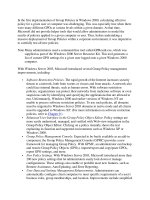Tài liệu Adding Restrictions to DataTable and DataColumn Objects phần 3 ppt
Bạn đang xem bản rút gọn của tài liệu. Xem và tải ngay bản đầy đủ của tài liệu tại đây (30.29 KB, 7 trang )
myPrimaryKey = OrderID
myDataColumn.ColumnName = OrderID
myDataColumn.DataType = System.Int32
myDataColumn.AllowDBNull = False
myDataColumn.AutoIncrement = False
myDataColumn.AutoIncrementSeed = 0
myDataColumn.AutoIncrementStep = 1
myDataColumn.MaxLength = -1
myDataColumn.ReadOnly = False
myDataColumn.Unique = True
Reading from the Order Details DataTable:
myPrimaryKey = OrderID
myPrimaryKey = ProductID
myDataColumn.ColumnName = OrderID
myDataColumn.DataType = System.Int32
myDataColumn.AllowDBNull = False
myDataColumn.AutoIncrement = False
myDataColumn.AutoIncrementSeed = 0
myDataColumn.AutoIncrementStep = 1
myDataColumn.MaxLength = -1
myDataColumn.ReadOnly = False
myDataColumn.Unique = False
myDataColumn.ColumnName = ProductID
myDataColumn.DataType = System.Int32
myDataColumn.AllowDBNull = False
myDataColumn.AutoIncrement = False
myDataColumn.AutoIncrementSeed = 0
myDataColumn.AutoIncrementStep = 1
myDataColumn.MaxLength = -1
myDataColumn.ReadOnly = False
myDataColumn.Unique = False
myDataColumn.ColumnName = UnitPrice
myDataColumn.DataType = System.Decimal
myDataColumn.AllowDBNull = True
myDataColumn.AutoIncrement = False
myDataColumn.AutoIncrementSeed = 0
myDataColumn.AutoIncrementStep = 1
myDataColumn.MaxLength = -1
myDataColumn.ReadOnly = False
myDataColumn.Unique = False
Adding Restrictions by Calling the DataAdapter Object's FillSchema() Method
Instead of adding restrictions yourself, you can add them by calling the FillSchema()
method of your DataAdapter. The FillSchema() method does the following:
•
Copies the schema information from the database.
•
Creates DataTable objects in your DataSet if they don't already exist.
•
Adds the constraints to the DataTable objects.
•
Sets the properties of the DataColumn objects appropriately.
The properties of the DataColumn objects set by FillSchema() include the following:
•
The DataColumn name-which is stored in the ColumnName property.
•
The DataColumn .NET data type-which is stored in the DataType property.
•
The maximum length of a variable length data type-which is stored in the
MaxLength property.
•
Whether the DataColumn can accept a null value-which is stored in the
AllowDBNull property.
•
Whether the DataColumn value must be unique-which is stored in the Unique
property.
•
Any auto-increment information-which is stored in the AutoIncrement,
AutoIncrementSeed, and AutoIncrementStep properties.
The FillSchema() method will also determine whether the DataColumn is part of a
primary key and store that information in the PrimaryKey property of the DataTable.
Warning
FillSchema() does not automatically add ForeignKeyConstraint objects to the
DataTable objects. Neither does it retrieve the actual rows from the database; it
retrieves only the schema information.
The FillSchema() method is overloaded, with the most commonly used version of this
method being the following:
DataTable[] FillSchema(DataSet myDataSet, SchemaType mySchemaType)
where mySchemaType specifies how you want to handle any existing schema mappings.
You set mySchemaType to one of the constants defined in the System.Data.SchemaType
enumeration. Table 11.7
shows the constants defined in the SchemaType enumeration.
Table 11.7: SchemaType ENUMERATION MEMBERS
CONSTANT DESCRIPTION
Mapped Apply any existing table mappings to the incoming schema and configure
the DataSet with the transformed schema. This is the constant you should
typically use.
Source Ignore any table mappings and configure the DataSet without any
transformations.
Let's take a look at an example that contains a call to the FillSchema() method. Notice the
call uses the SchemaType.Mapped constant to apply any existing table mappings:
SqlCommand mySqlCommand = mySqlConnection.CreateCommand();
mySqlCommand.CommandText =
"SELECT ProductID, ProductName " +
"FROM Products;" +
"SELECT OrderID " +
"FROM Orders;" +
"SELECT OrderID, ProductID, UnitPrice " +
"FROM [Order Details];";
SqlDataAdapter mySqlDataAdapter = new SqlDataAdapter();
mySqlDataAdapter.SelectCommand = mySqlCommand;
DataSet myDataSet = new DataSet();
mySqlConnection.Open();
mySqlDataAdapter.FillSchema(myDataSet, SchemaType.Mapped);
mySqlConnection.Close();
myDataSet.Tables["Table"].TableName = "Products";
myDataSet.Tables["Table1"].TableName = "Orders";
myDataSet.Tables["Table2"].TableName = "Order Details";
The call to FillSchema() copies the schema information from the Products, Orders, and
Order Details tables to myDataSet, setting the PrimaryKey property of each DataTable
and the properties of the DataColumn objects appropriately.
Listing 11.2
shows the use of the FillSchema() method.
Listing 11.2: FILLSCHEMA.CS
/*
FillSchema.cs illustrates how to read schema information
using the FillSchema() method of a DataAdapter object
*/
using System;
using System.Data;
using System.Data.SqlClient;
class FillSchema
{
public static void Main()
{
SqlConnection mySqlConnection =
new SqlConnection(
"server=localhost;database=Northwind;uid=sa;pwd=sa"
);
SqlCommand mySqlCommand = mySqlConnection.CreateCommand();
mySqlCommand.CommandText =
"SELECT ProductID, ProductName " +
"FROM Products;" +
"SELECT OrderID " +
"FROM Orders;" +
"SELECT OrderID, ProductID, UnitPrice " +
"FROM [Order Details];";
SqlDataAdapter mySqlDataAdapter = new SqlDataAdapter();
mySqlDataAdapter.SelectCommand = mySqlCommand;
DataSet myDataSet = new DataSet();
mySqlConnection.Open();
mySqlDataAdapter.FillSchema(myDataSet, SchemaType.Mapped);
mySqlConnection.Close();
myDataSet.Tables["Table"].TableName = "Products";
myDataSet.Tables["Table1"].TableName = "Orders";
myDataSet.Tables["Table2"].TableName = "Order Details";
// display the details of the DataColumn objects for
// the DataTable objects
foreach (DataTable myDataTable in myDataSet.Tables)
{
Console.WriteLine("\n\nReading from the " +
myDataTable + "DataTable:\n");
// display the primary key
foreach (DataColumn myPrimaryKey in myDataTable.PrimaryKey)
{
Console.WriteLine("myPrimaryKey = " + myPrimaryKey);
}
// display the constraints
foreach (Constraint myConstraint in myDataTable.Constraints)
{
Console.WriteLine("myConstraint.IsPrimaryKey = " + ((UniqueConstraint)
myConstraint).IsPrimaryKey);
foreach (DataColumn myDataColumn in ((UniqueConstraint)
myConstraint).Columns)
{
Console.WriteLine("myDataColumn.ColumnName = " +
myDataColumn.ColumnName);
}
}
// display some of the details for each column
foreach (DataColumn myDataColumn in myDataTable.Columns)
{
Console.WriteLine("\nmyDataColumn.ColumnName = " +
myDataColumn.ColumnName);
Console.WriteLine("myDataColumn.DataType = " +
myDataColumn.DataType);
Console.WriteLine("myDataColumn.AllowDBNull = " +
myDataColumn.AllowDBNull);
Console.WriteLine("myDataColumn.AutoIncrement = " +
myDataColumn.AutoIncrement);
Console.WriteLine("myDataColumn.AutoIncrementSeed = " +
myDataColumn.AutoIncrementSeed);
Console.WriteLine("myDataColumn.AutoIncrementStep = " +
myDataColumn.AutoIncrementStep);
Console.WriteLine("myDataColumn.MaxLength = " +
myDataColumn.MaxLength);
Console.WriteLine("myDataColumn.ReadOnly = " +
myDataColumn.ReadOnly);
Console.WriteLine("myDataColumn.Unique = " +
myDataColumn.Unique);
}
}
}
}
The output from this program is as follows:









